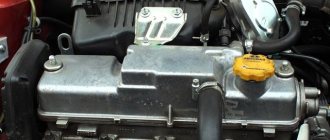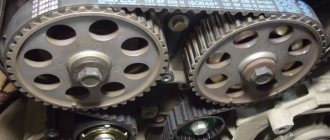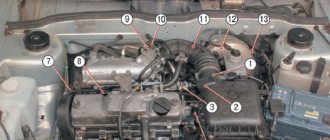Since 1990, the manufacturer Auto VAZ has been working on two projects - the development of an engine for the Niva with more power than the 2121, and the creation of an internal combustion engine for the Zhiguli 2107. As a result, the projects were combined, the resulting engine 21213 was used to equip the Lada 4x4, it is not used for the “seven”. got in because it was more suitable for the 2121 model range of all-wheel drive cars.
The requirements for an SUV engine at the time of design were:
- increase power and torque, at least at medium speeds;
- ensure acceptable fuel consumption within 12 l/100 km;
- provide a basis for injection modification in the future.
ICE 21213
The engine uses a crankshaft with a “long” crank radius and 82 mm cylinders. If the gas distribution mechanism drive breaks, it bends the valves, but at 3000 rpm the torque is 126 Nm, and the power is increased to 81 hp. With. Factory tuning used a modernized attachment - a Solex carburetor, and increased volumes of combustion chambers.
Solex carburetor
The engine layout remaining from classic rear-wheel drive models - a longitudinal arrangement under the hood relative to the movement - was suitable for an all-wheel drive layout without modifications.
The resulting technical characteristics of version 21213 are as follows:
| Manufacturer | AvtoVAZ |
| Engine brand | 21213 |
| Years of production | 1994 – … |
| Volume | 1690 cm3 (1.7 l) |
| Power | 61 kW (82 hp) |
| Torque moment | 126 Nm (at 3000 rpm) |
| Weight | 117 kg |
| Compression ratio | 9,3 |
| Nutrition | Solex carburetor |
| Motor type | in-line |
| Ignition | distributor |
| Number of cylinders | 4 |
| Location of the first cylinder | TVE |
| Number of valves on each cylinder | 2 |
| Cylinder head material | aluminum alloy |
| Intake manifold | duralumin |
| An exhaust manifold | cast iron |
| Camshaft | original cam profile |
| Cylinder block material | cast iron |
| Cylinder diameter | 82 mm |
| Pistons | original |
| Crankshaft | from 2103 |
| Piston stroke | 80 mm |
| Fuel | AI-92 |
| Environmental standards | Euro-0 |
| Fuel consumption | highway – 8.3 l/100 km combined cycle 10.5 l/100 km city – 11.5 l/100 km |
| Oil consumption | maximum 0.7 l/1000 km |
| What kind of oil to pour into the engine by viscosity | 5W30, 5W40, 10W40, 15W40 |
| Which engine oil is best by manufacturer | Liqui Moly, LukOil, Rosneft |
| Oil for 21213 according to composition | synthetic in winter, semi-synthetic in summer |
| Engine oil volume | 3.75 l |
| Operating temperature | 95° |
| ICE resource | declared 80,000 km actual 160,000 km |
| Adjustment of valves | nuts |
| Cooling system | forced, antifreeze |
| Coolant volume | 10.7 l |
| water pump | with plastic impeller |
| Candles for 21213 | BCPR6ES from NGK or domestic AU17DVRM |
| Spark plug gap | 1.1 mm |
| Valve train chain | double-row, from 2103 with a new tensioner shoe design |
| Cylinder operating order | 1-3-4-2 |
| Air filter | Nitto, Knecht, Fram, WIX, Hengst |
| Oil filter | with check valve |
| Flywheel | with clutch landing diameter 200 mm or 215 mm |
| Flywheel mounting bolts | M12x1.25 mm, length 26 mm |
| Valve stem seals | manufacturer Goetze, inlet light, exhaust dark |
| Compression | from 10 bar, difference in adjacent cylinders maximum 1 bar |
| XX speed | 750 – 800 min-1 |
| Tightening force of threaded connections | spark plug – 31 – 39 Nm flywheel – 62 – 87 Nm clutch bolt – 19 – 30 Nm bearing cap – 68 – 84 Nm (main) and 43 – 53 (rod) cylinder head – three stages 20 Nm, 69 – 85 Nm + 90° + 90° |
Taking into account the year of manufacture (1994) and the low compression ratio (9.3 units), users filled in 92 gasoline, and the engine manufacturer recommended AI 91 - 93. Compliance with the environmental protocol has not yet been discussed, so the engine is considered Euro-0.
Characteristics of motor 21213
The requirements for an SUV engine at the time of design were:
- increase power and torque, at least at medium speeds;
- ensure acceptable fuel consumption within 12 l/100 km;
- provide a basis for injection modification in the future.
ICE 21213
The engine uses a crankshaft with a “long” crank radius and 82 mm cylinders. If the gas distribution mechanism drive breaks, it bends the valves, but at 3000 rpm the torque is 126 Nm, and the power is increased to 81 hp. With. Factory tuning used a modernized attachment - a Solex carburetor, and increased volumes of combustion chambers.
Solex carburetor
The engine layout remaining from classic rear-wheel drive models - a longitudinal arrangement under the hood relative to the movement - was suitable for an all-wheel drive layout without modifications.
The resulting technical characteristics of version 21213 are as follows:
| Manufacturer | AvtoVAZ |
| Engine brand | 21213 |
| Years of production | 1994 – … |
| Volume | 1690 cm3 (1.7 l) |
| Power | 61 kW (82 hp) |
| Torque moment | 126 Nm (at 3000 rpm) |
| Weight | 117 kg |
| Compression ratio | 9,3 |
| Nutrition | Solex carburetor |
| Motor type | in-line |
| Ignition | distributor |
| Number of cylinders | 4 |
| Location of the first cylinder | TVE |
| Number of valves on each cylinder | 2 |
| Cylinder head material | aluminum alloy |
| Intake manifold | duralumin |
| An exhaust manifold | cast iron |
| Camshaft | original cam profile |
| Cylinder block material | cast iron |
| Cylinder diameter | 82 mm |
| Pistons | original |
| Crankshaft | from 2103 |
| Piston stroke | 80 mm |
| Fuel | AI-92 |
| Environmental standards | Euro-0 |
| Fuel consumption | highway – 8.3 l/100 km combined cycle 10.5 l/100 km city – 11.5 l/100 km |
| Oil consumption | maximum 0.7 l/1000 km |
| What kind of oil to pour into the engine by viscosity | 5W30, 5W40, 10W40, 15W40 |
| Which engine oil is best by manufacturer | Liqui Moly, LukOil, Rosneft |
| Oil for 21213 according to composition | synthetic in winter, semi-synthetic in summer |
| Engine oil volume | 3.75 l |
| Operating temperature | 95° |
| ICE resource | declared 80,000 km actual 160,000 km |
| Adjustment of valves | nuts |
| Cooling system | forced, antifreeze |
| Coolant volume | 10.7 l |
| water pump | with plastic impeller |
| Candles for 21213 | BCPR6ES from NGK or domestic AU17DVRM |
| Spark plug gap | 1.1 mm |
| Valve train chain | double-row, from 2103 with a new tensioner shoe design |
| Cylinder operating order | 1-3-4-2 |
| Air filter | Nitto, Knecht, Fram, WIX, Hengst |
| Oil filter | with check valve |
| Flywheel | with clutch landing diameter 200 mm or 215 mm |
| Flywheel mounting bolts | M12x1.25 mm, length 26 mm |
| Valve stem seals | manufacturer Goetze, inlet light, exhaust dark |
| Compression | from 10 bar, difference in adjacent cylinders maximum 1 bar |
| XX speed | 750 – 800 min-1 |
| Tightening force of threaded connections | spark plug – 31 – 39 Nm flywheel – 62 – 87 Nm clutch bolt – 19 – 30 Nm bearing cap – 68 – 84 Nm (main) and 43 – 53 (rod) cylinder head – three stages 20 Nm, 69 – 85 Nm + 90° + 90° |
Taking into account the year of manufacture (1994) and the low compression ratio (9.3 units), users filled in 92 gasoline, and the engine manufacturer recommended AI 91 - 93. Compliance with the environmental protocol has not yet been discussed, so the engine is considered Euro-0.
Repair dimensions of cylinders and pistons of the VAZ 21213 engine during major repairs
| Repair cylinder size, mm | Piston and cylinder class | Piston diameter, mm | Cylinder diameter after boring, mm | Cylinder diameter after honing, mm |
| 1 repair | ||||
| 82,4 | A | 82,34-82,35 | 82,37-82,38 | 82,40-82,41 |
| B | 82,35-82,36 | 82,38-82,39 | 82,41-82,42 | |
| C | 82,36-82,37 | 82,39-82,40 | 82,42-82,43 | |
| D | 82,37-82,38 | 82,40-82,41 | 82,43-82,44 | |
| E | 82,38-82,39 | 82,41-82,42 | 82,44-82,45 | |
| 2 repairs | ||||
| 82,8 | A | 82,74-82,75 | 82,77-82,78 | 82,80-82,81 |
| B | 82,75-82,76 | 82,78-82,79 | 82,81-82,82 | |
| C | 82,76-82,77 | 82,79-82,80 | 82,82-82,83 | |
| D | 82,77-82,78 | 82,80-82,81 | 82,83-82,84 | |
| E | 82,78-82,79 | 82,81-82,82 | 82,84-82,85 | |
Also interesting: Where is the fuel pump fuse for Niva Chevrolet
Design Features
The 21213 engine was created from the working version 2121, taking into account new developments for the VAZ 2107 engine, which were never completed. The main differences from the Niva internal combustion engine are:
- new design pistons;
- changing the parameters of the cylinder head and connecting rods;
- crankshaft modernization;
- camshaft modification;
- use of Solex carburetor modification 21073;
- improved lubrication system;
- original design of the chain tensioner shoe.
Pistons 21213
Crankshaft
Chain tensioner shoe
A detailed description of the components is contained in the manufacturer's manual. To reduce costs, designers mainly used parts of engines already in production that were already in mass production at the time of 1994:
- standard cylinder block, from 2103, height 214.58 mm, cylinder center distance 95 mm;
- crankshaft - taken from 2103 with a crank radius of 40 mm, equipped with additional counterweights, oil channels are drilled in the connecting rod journals, and their diameters are increased by 0.02 mm;
- the cylinder head was used from 21011, but the combustion chambers were enlarged (30 cm3 each), the height was ground down to 111 mm;
- timing valve mechanism – used from 2101 without changes;
- Timing chain – bush-roller double-row from 2103.
Cylinder head 21213
Factory boost provided a power of 81 hp. s and a torque of 126 Nm, but the manufacturer left a potential of about 45 - 60 hp. With. At the same time, he recommends improving the intake and exhaust tracts with your own hands without boring the cylinders and turbocharging the engine.
The main feature of the lubrication system is the presence of plugs to accumulate and then remove dirt from the oil.
Disadvantages of the VAZ 21213 power unit
Niva engines have excellent technical characteristics and have proven themselves to be quite reliable power units. At the same time, it should be understood that, like all other VAZ power units, they are not without drawbacks.
The disadvantages of this motor include:
Such problems often appear after a mileage of 100,000 kilometers. Car owners need to closely monitor the condition of the cooling system.
Often, problems with the pump and thermostat lead to overheating of the power unit. The result of such overheating can be the appearance of cracks in the cylinder head, which in turn leads to coolant entering the oil. The VAZ 21213 engine in this case requires complex and expensive repairs.
- Water pump;
- Engine, manual transmission and transfer case oil seals;
- Generator;
- Starter;
- manual transmission;
- Valve cover gasket;
- Cooling system pipe connections;
- Radiator;
- Thermostat;
- Expansion tank;
- Vacuum brake booster.
The water pump (pump) is characterized by frequent failures on new cars after 2,000 km.
Due to poor quality, oil seals require more frequent replacement than required according to the operating manual.
The generator has a high probability of failure. As a rule, it burns out even on new cars that have not reached 4,000-10,000 km.
The starter has a low service life without repair.
On a gearbox, one of the common defects is the fifth gear slipping out. In addition, the gears are not fully engaged.
The valve cover gasket loses its properties over time and allows oil to leak out.
The connections of the cooling system pipes in the places where the clamps are installed are not reliable and lose their tightness very early, which is fraught with loss of antifreeze.
The radiator is leaking. The problem occurs due to the appearance of cracks in the radiator pipe package, accompanied by loss of coolant. This defect has become widespread.
The thermostat does not provide thermal conditions for the coolant in the engine cooling system. The manifestation of this problem is no exception. The cause of the defect is a failure of the valve mechanism inside the thermostat. To check that the thermostat is working properly, after starting the engine, simply place your palm on the lower (outlet) hose, through which hot antifreeze circulates into the radiator for cooling. If the thermostat is working properly, after some time the hose should become hot; if the hose remains cold, the thermostat must be replaced.
The expansion tank cracks and antifreeze leaks out. The appearance of cracks occurs due to the failure of the steam-air valve in the tank plug due to increased pressure.
Vacuum brake booster (VUT). Manifested by a stiff brake pedal. The speed may fluctuate when the brake pedal is pressed, as well as hissing. The problem is solved by replacing failed rubber products and replacing clamps in connections.
- Vibration at speed 80-90 km;
- Unreliable timing tensioner design;
- Ignition module;
- The fuel pump is noisy;
- Low torque;
- Long stroke of the gear lever;
- When the timing chain breaks, the valves bend;
- Vibration of the gear lever;
- Poor dynamics on the highway due to insufficient power.
And also interesting: How to make a transfer case subframe for a Niva with your own hands || Niva engine subframe
Conclusion.
PS. Dear Nivovody! I look forward to your comments, questions and feedback on the problems that have arisen, weaknesses and shortcomings during the operation, maintenance and repair of the VAZ 21213 engine.
Advantages and disadvantages
At the time of its creation, ICE 21213 had the following advantages over earlier versions:
- trouble-free carburetor - does not require frequent adjustments, when adjusted by a specialist, it ensures gasoline consumption at the level of injection injection;
- improved performance - in addition to power/torque, speed and throttle response have increased;
- several repair sizes of ShPG - major repairs can be performed several times without purchasing a new unit.
ShPG 21213
The disadvantage is the excessive noise during operation of the internal combustion engine, high consumption of fuel and lubricants and antifreeze. Currently, instead of standard elastic cylinder head gaskets, metal packages with a long service life can be used. However, machine grinding of the surface of the head and block, respectively, will be required.
Users note among the disadvantages of the motor the low quality of the factory assembly. For example, the connecting rod pin bushings are pressed in incorrectly - with a cut in an arbitrary direction. And these parts experience maximum loads at dead spots, so in the literature it is recommended to press them either at 45 degrees or in a horizontal direction, which will increase the service life of this consumable.
Tuning the VAZ 2130 engine
Refinement of the Niva 1.8 engine by increasing the displacement
The most economical and simple tuning of the VAZ 2130 engine is boring the cylinders for an 84 mm piston. The second stage is installing a crankshaft with an increased piston stroke to 86, 88 and 90 mm. All these options are possible with the selection of an appropriate short connecting rod and piston with a pin offset.
Boring of VAZ 2130 engine
- larger diameter piston, standard stroke 1.9 liters. 84x84 - larger diameter piston, increased stroke 2.0 liters. 84x88 Torque tractor motor.
This block with bored cylinder head channels, a lightweight flywheel and valves allows you to easily produce about 100 hp. And using the well-known Nuzhdin 10.5 camshaft and a modified carburetor (enlarged diffusers), we have a configuration with an output of more than 105 hp. With a volume of 1.9 with a Nuzhdin 11.2 shaft, we get about 110 hp.
Turbo for VAZ 2130
Due to the relatively low compression ratio, the engine can be inflated without the hassle of lowering the compression ratio. We take a ready-made turbo kit, or assemble it ourselves and install it on a standard engine. For the engine to live happily ever after, blow no more than 0.5-0.6 bar. What are the advantages of a turbine... moment, the turbine will provide torque, and this is exactly what is needed on an SUV. What are the disadvantages of a turbine in the field, the high cost of implementing the project. If you installed the 2130 engine on a classic and the goal of the build is speed, then you need a high-pressure turbine and, in general, you will need an expensive (more expensive than a car) comprehensive modification, also you will always run into an 8-valve cylinder head, it is much more efficient to do a swap of the engine 2112 or 21126 and squeeze out 150-200-250++ hp without any problems, this process is described HERE.
Compressor for VAZ 2130
As in the section with the turbine, we take a ready-made kit with a pressure of 0.5 bar or assemble a similar one ourselves and install it on a standard engine. The pros and cons are similar to the turbine, but the compressor will give a slightly smaller increase, due to the fact that it takes power to operate itself. Eaton compressors from the Mercedes M271 engine have become widespread, the pressure is still the same - 0.5 bar.
To increase the efficiency of a turbine or compressor, you need to bore the inlet and outlet channels of the cylinder head (intake 33mm, exhaust 31mm) and install lightweight valves. Going further is expensive and pointless.
ENGINE RATING: 1
What cars was it used in?
The 21213 engine was installed on several AvtoVAZ cars:
- Niva 21213 – domestic three-door SUV;
- Lada 21313 - an extended five-door version of the Niva;
- Nadezhda 2120 is a Russian minivan.
Nadezhda 2120
Compared to the basic version 2121, the engine characteristics are much better; the engine is still produced.
Maintenance
For normal operation, engine 21213 should be serviced within the specified periods:
- 10,000 km - change the oil along with the filter;
- 20,000 km – checking the functionality of the thermostat, updating the cabin filter;
- 30,000 km – replacement of the fuel and air filters;
- 60,000 km – spark plugs and batteries are renewed and the crankcase ventilation is cleaned;
- 100,000 km – reinstallation of the oxygen sensor;
- 200,000 km - the timing chain may need to be replaced.
Despite the fact that the internal combustion engine device is copied from longitudinal engines with a much higher service life, it is used on an SUV with non-disconnectable all-wheel drive, so the components wear out more intensively.
Malfunctions: causes, elimination
Based on the results of many years of operation, motor 21213 has the following breakdowns:
| The engine does not start | 1) the carburetor damper does not open when ignited 2) fuel pump failure 3) there is no gasoline inside the carburetor | 1) sealing the starting device 2) replacement or repair 3)washing filters and fuel lines |
| Engine stalls in idle mode | 1) failure of the control system 2) damaged drainage tube 3) failure of XX adjustments | 1)replacement of hoses, gaskets and fittings 2) tube replacement 3) adjusting the idle speed with screws |
| Increased vibrations | Spark plugs are not working correctly | Replacing spark plugs |
| Reduced throttle response and power | 1) the dampers do not open enough 2) clogged air filter 3) ignition failure 4) fuel pump failure 5) carburetor failure | 1) adjusting the remote control drive 2) replacement of consumables 3)repairs and adjustments 4)repair 5) settings or cleaning |
The official operating manual of the AvtoVAZ manufacturer contains step-by-step actions that allow you to carry out major repairs or scheduled maintenance on your own.
Motor design 21213
Technical characteristics of the carburetor version
The VAZ 21213 four-cylinder eight-valve petrol engine has a displacement of 1.7 liters. The power of the power unit is 81 horsepower with a torque of 125 Nm.
Engines 21213 in their latest generation were equipped with an injector and ran on high-octane 93 gasoline. The cast iron cylinder block ensured maximum strength for this power unit.
The use of numerous automatic engine control systems made it possible not only to change the traction performance of this engine, but also significantly improved fuel efficiency. Niva in suburban mode consumes 8.3 liters of gasoline per 100 kilometers when driving at cruising speed.
Starting from 2014, Niva cars with a diesel engine are also offered to customers.
Also interesting: Niva generator transfer bracket drawing
The Niva engine with an overhead camshaft is equipped with a chain drive, which significantly simplifies the service of this power unit. The chain drive does not require replacement of the tensioner or any adjustment during operation of the motor. We also note the presence of hydraulic compensators, which relieves the car owner of the need to carry out the procedure for adjusting the valve clearance. All maintenance work on this engine can be performed by the car owner himself, without contacting branded service stations.
Let's look at what is better - a Niva carburetor or an injector. If we talk about the first version, it is considered older and archaic. The main component in this system is the carburetor. It is this mechanism that mixes a portion of gasoline with air, creating a flammable mixture. This system has a simple device.











